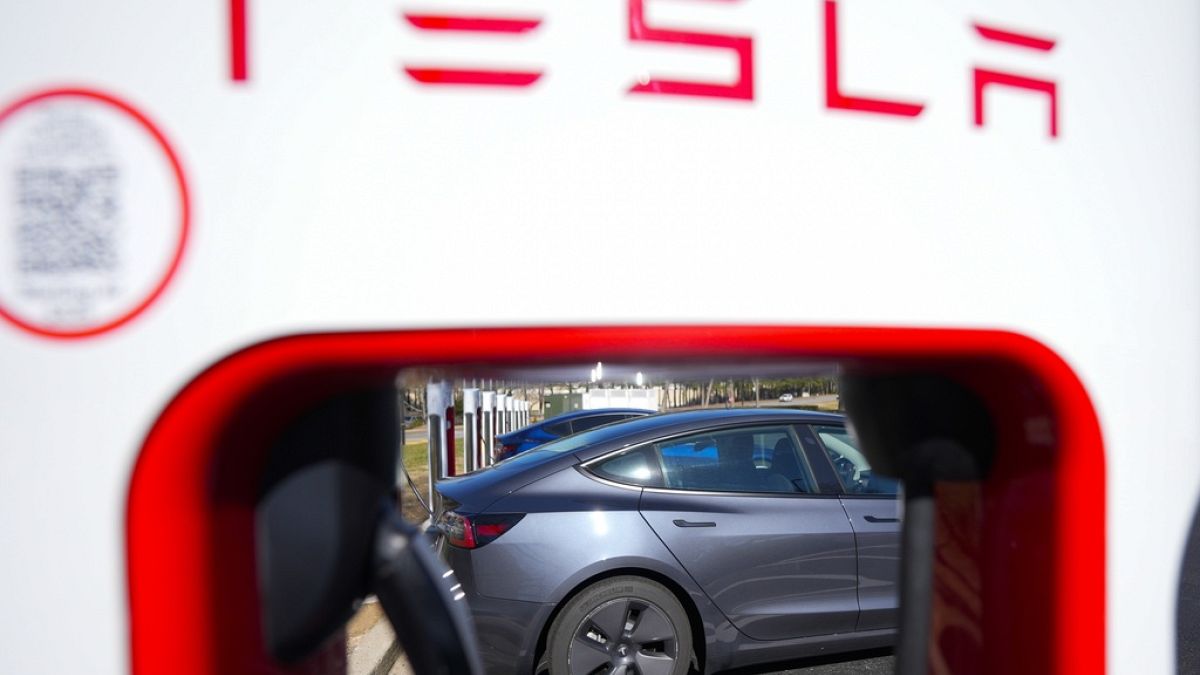The car company that has faced boycotts for months said Wednesday that revenue dropped 12% and net income slumped 16% in the three months up to June, compared to the previous year, as buyers continued to stay away.
“The perception of Elon Musk, its chief executive, has rubbed the sheen right out of what once was a darling and soaring automotive brand,” wrote Forrester analyst Dipanjan Chatterjee in an email. Adding that, Tesla is “a toxic brand that is inseparable from its leader.”
Quarterly profits at the electric vehicle, battery and robotics company fell to $1.17 billion (€990 million), or 33 cents a share, from $1.4bn (€1.19bn), or 40 cents a share. That was the third quarter in a row that profit dropped. On an adjusted basis, the company said it earned 40 cents a share, matching Wall Street estimates.
Revenue fell from $25.5bn (€21.7bn) to $22.5bn (€19.1bn) in the April through June period, slightly above Wall Street’s forecast.
Tesla shares fell more than 4.4% in after-hours trading in the US.
Are robotaxis going to save Tesla’s earnings?
Musk spent the company’s earnings conference call talking less about car sales and more about robotaxis, automated driving software and robotics, which he says is the future of the company. But those businesses have yet to take off, and the gap between promise and profit was apparent in the second quarter.
“It appears management’s focus will now shift to robotaxis and away from deliveries growth,” said Morningstar analyst Seth Goldstein, referring to car sales.
A big challenge is that potential buyers, not just in the US but Europe, are still balking at buying Teslas. Musk alienated many in the market for cars in Great Britain, France, Germany and elsewhere by embracing far-right politicians there. And rival electric vehicle makers such as China’s BYD and Germany’s Volkswagen have pounced on the weakness, stealing market share.
Tesla began a rollout in June of its paid robotaxi service in Austin, Texas, and hopes to introduce the driverless cabs in several other cities soon.
In the post-earnings call, Musk said the service will be available to probably “half of the population of the US by the end of the year — that’s at least our goal, subject to regulatory approvals.”
He added, “We are being very cautious. We don’t want to take any chances.”
The test run in Austin has mostly gone off without a hitch, though there have been a few alarming incidents, such as when a robotaxi went down a lane meant for opposing traffic.
With autonomous taxis, though, the billionaire who upended the space race and EV manufacturing faces tough competition. The dominant provider now, Waymo, is already in several cities and recently logged its ten-millionth paid trip.
Tesla CEO Elon Musk warns that rough quarters are coming
Meanwhile, other threats loom. The new federal budget just passed by Congress eliminates a credit worth as much as $7,500 for buying an electric car. It also wipes out penalties for car makers exceeding carbon emission standards. That threatens Tesla’s business of selling its “carbon credits” to traditional car companies that regularly fall short of those standards.
Tesla generated $439 million (€373.3 million) from credit sales in Q2, down sharply from $890 million (€756.9 million) a year ago.
“We’re in this weird transition period where we’ll lose a lot of incentives in the US,” Musk said, predicting several rough quarters ahead. He added, though, “Once you get to autonomy at scale in the second half of next year, certainly by the end of next year, I would be surprised if Tesla’s economics are not very compelling.”
One way for Tesla to boost sales while waiting for that future: A cheaper model. The company is now planning to introduce that to the market in the last three months of the year. Tesla had previously said that it was going to happen by June this year.
Musk also said he expected regulatory approval to introduce its so-called Full Self-Driving software in some parts of Europe by the end of the year. Musk had previously expected that to happen by March 2025. The feature, which is available in the US, is a misnomer because it is only a driver-assistance feature.
Tesla robots
In the robot business, Musk said he expects explosive growth as Tesla ramps up production of its humanoid Optimus helpers to 100,000 a month in five years time.
“We’ll go from a world where robots are rare to where they’re so common that you don’t even look up,” he said.
Asked about whether he would want more than his current 13% stake in Tesla to keep control, Musk said he did want more but not too much.
“I think my control over Tesla should be enough to ensure that it goes in a good direction,” he said, “but not so much control that I can’t be thrown out if I go crazy.”
Gross margins for the quarter, a measure of earnings for each dollar of revenue, fell to 17.2% from 18% a year earlier.
A highlight from the quarter was from something far removed from cars and robots: the company’s investment in bitcoin. That bet generated a $284 million (€241.5 million) paper gain, compared with a loss the previous quarter.

